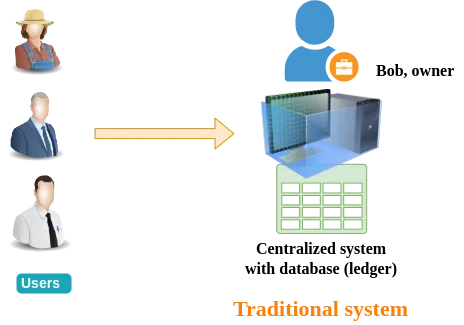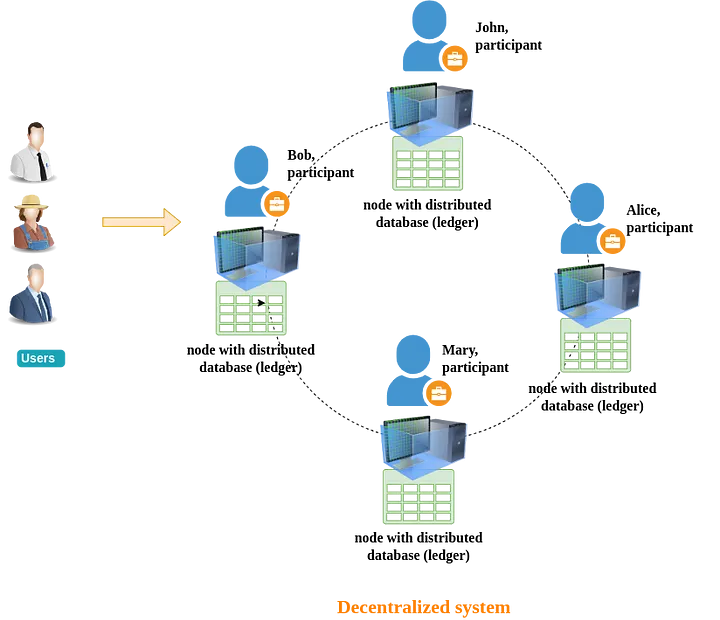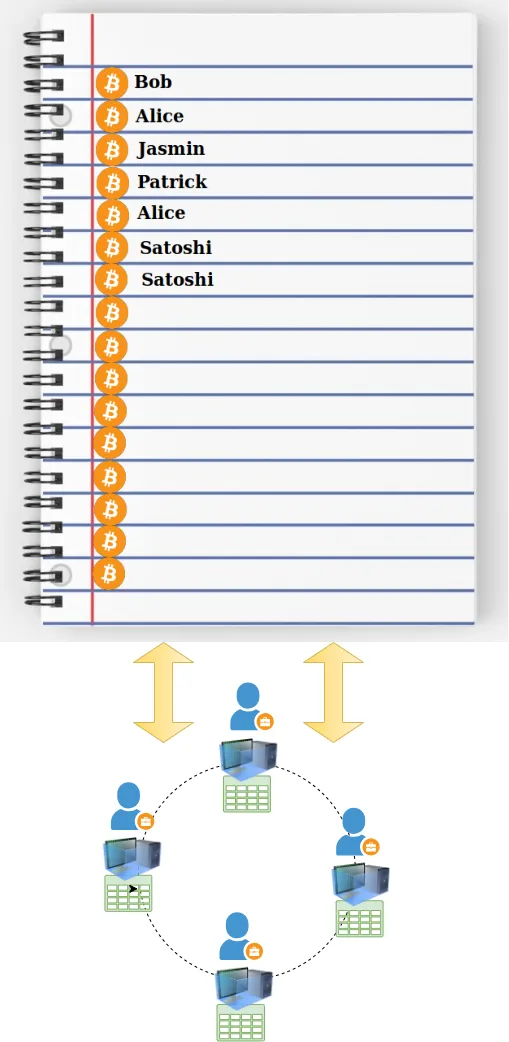Learn the ABCs of #blockchain and #cryptocurrency in simple language! Find out simple answers to essential questions like “#What is blockchain?” and “#What is cryptocurrency?”. Explore how #Bitcoin, the pioneer cryptocurrency, changed the game in digital finance.
***
Introduction
Today let’s return to the basics to refresh understanding of answers to the very fundamental terms
What is blockchain? What is cryptocurrency?
Let’s discuss this in simple language as such as a even a child could grasp it. This is absolutely necessary to find the answer to the logically following ones: How to gauge blockchain? How to estimate cryptocurrency? How to earn with cryptocurrencty?
Let’s get started….
***
What is blockchain?
Imagine that you have a computer with a database that stores a list of all students. The owner of this computer is Bob. To add a record about a new student, you make agreement with Bob, and he makes changes to the student database on this computer. Anyone wanting to make changes must get Bob’s approval.
This is a model of so-called centralized systems:

Now imagine that you now have many computers. These computers are united into one network. All computers have the same database installed, which stores a list of all students. To add a record of a new student, you must simultaneously make changes to this student database on all these computers. Otherwise, changes will not be made anywhere. And each computer has its own owner. That is, in order to make changes you must agree not only with Bob, but also with all other computer owners. Either the owners will approve the changes or they will not. Group consent must be obtained for changes to be made. At the same time, none of the computer owners can make changes independently; they must also obtain group consent. You can approach any of the participants and ask to make changes, but in any case, a group agreement (consensus) of everyone will be required.
This is a model of so-called decentralized systems:

In other words, the database is called a ledger.
Blockchain technology is a distributed and decentralized database (ledger), consisting of many nodes that make up this ledger, between which data synchronization occurs.
!!! Blockchain is a distributed and decentralized database. !!!
In a blockchain there cannot be one owner of the system, unlike traditional systems!!!
Consensus in the blockchain is the agreement of participants to make changes to the decentralized database (ledger)
In this review we will not focus on the technological side of how it works. The main thing for us is to understand the logic. I hope we all have received (refreshed) an idea of what blockchain is. Let’s move on.
The first and most famous blockchain project today is #Bitcoin. Let me continue to explain in simple terms to visualize this project. A long time ago, in 2009, a mysterious man named Satoshi Nakamoto introduced Bitcoin to the world. But no one knows for sure who Satoshi Nakamoto really is — it’s kind of like a pseudonym! Some people think it could be one person, while others think it could be a group of smart people working together. There is even a theory according to which Bitcoin was invented to eventually replace the US dollar as the main means of exchange in world trade. The idea of Bitcoin is indecently simple. Imagine a large notebook in which 10 million (for instance) lines (records) were made. Each line can contain the note regarding who is the owner of that line. But not necessary. Also, the owner of the entry may change. However, there is no single owner of this large notebook. This notebook is owned by many people at once, and in order to make changes to the notebook, you need to obtain agreement of everyone at once. Due to this notebook is a decentralized database, in other words, it is a blockchain (see explanation above). Anyone can be recorded as the owner of the notebook entry. It was assumed that being the owner of one of the conditional 10 million entries in the notebook is a value for which people will be willing to pay real money and exchange this privilege for services and goods. Both the blockchain itself (conditional notebook) and the record in this blockchain, mentioned above, are called the same — Bitcoin.

This is and is Bitcoin :)
It is a fun fact that in 2010, 10,000 records (bitcoins) in the Bitcoin blockchain were sold for two pizzas costing about $20. Thus, in 2010, one entry was estimated at $0.002. Today one entry is valued at over $70,000.
***
What is cryptocurrency?
Now back to the question, what is Cryptocurrency?
Today, there are tens of thousands of crypto-projects built on blockchain technology with their own cryptocurrency.
!!! Tens of thousands of cryptocurrencies on the market!!!
So what is cryptocurrency, and how does it relate to blockchain?
Each line in the notebook picture above is called a token in the blockchain world. With some exceptions, all crypto projects on their launch make, as a rule, a limited amount of such records (tokens) for their project. The volume of tokens may be unlimited as well. The project may not have its own tokens at all. Project tokens are given a symbolic names. Like Bitcoin, Ethereum, UniSwap, USDT, etc. The ways to use tokens can be different, but it comes down to the fact that the token gives the owner some value that can be exchanged for something. And this is where the concept of cryptocurrency appears.
In the traditional world, Currency is a medium of exchange for goods and services. Since traditional currencies and gold cannot serve as a medium of exchange in the virtual space, a reliable replacement is required. And besides the replacement which will not have a single owner, who may disappear at one moment, turning off the server, or decide that some categories of exchange participants will no longer be able to use this means of exchange, devaluing their investments. As the example of the Bitcoin project showed, tokens of blockchain projects are a means of decentralized exchange in the virtual world, then they are a full-fledged cryptocurrency.
!!! Cryptocurrency is any token of any project made on blockchain technology that has sufficient value to be exchanged for other resources in the virtual space !!!
Unfortunately, we must admit that the vast majority of people today still believe that cryptocurrency is a big scam. Why?
Primarily because of the Lack of Understanding: Cryptocurrency and blockchain technology can be complex concepts to grasp. Many people don’t fully understand how they work, which can lead to skepticism and fear of the unknown.
Secondly, due to the perceived lack of Tangible Value: Unlike traditional currencies, which are backed by governments and central banks, cryptocurrencies are often perceived as having no intrinsic value
The next important point is regulatory uncertainty: the lack of clear and understandable regular practices on the part of Governments and regulatory bodies regarding the circulation of cryptocurrencies around the world.
From which the next factor follows. The lack of regulation of the cryptocurrency sector of economic relations by government agencies, as well as the inherent anonymity and decentralized nature of cryptocurrencies have made them attractive to scammers and fraudsters. There have been numerous cases of cryptocurrency-related scams, including Ponzi schemes, phishing attacks, and fraudulent initial coin offerings (ICOs). These incidents have tarnished the reputation of cryptocurrency in the eyes of the public.
And of course, the huge volatility of any cryptocurrency today is a deterrent. This is due to the immaturity of this market. Compared to traditional financial markets, cryptocurrency markets are relatively small and less liquid. This means that even a relatively small amount of buying or selling activity caused, for example, by a negative or positive news background, speculation, general market sentiments, news about exploited security vulnerabilities, etc. can have a significant impact on prices.
But!!!
Behind all this hype and bias for thinking and proactive people, cryptocurrencies open up great opportunities in the areas of financial services (investments, trading, loans, passive income), access to capital (crowdfunding platforms, initial coin offerings (ICOs) and token sales), in tokenization of the game industry/social networks/real-world assets, and in terms of establishing decentralized self-governing organizations.
The value of any cryptocurrency (token) depends on a number of factors, both technical and financial, that change over time. And, unfortunately, there is no simple answer to this problem yet. In order to highlight truly valuable, reliable and promising projects (and respectively their tokens), time is required for immersion in the subject area and analysis.
***
In conclusion
The interested reader can take away the following key takeaways from this article:
(1) Firstly, we looked at the concept of blockchain and reminded that Blockchain is like a digital ledger, or a big notebook, where records of transactions are stored. Unlike a regular notebook controlled by one person, blockchain is decentralized, meaning many computers share and agree on the information. This makes it secure and transparent.
(2) Secondly, using the example of the most famous cryptocurrency Bitcoin, we recalled the history of the origin of the concept of cryptocurrency. Bitcoin was the first blockchain project introduced in 2009 by someone named Satoshi Nakamoto. It’s like a digital version of money (medium of exchange) that operates on blockchain technology. Each “line” in the digital ledger represents a Bitcoin, and people can buy, sell, or trade them. This creates a means of exchange — cryptocurrency. The value of Bitcoin has increased significantly over time, making it a valuable asset today.
(3)Thirdly, we gave a definition of cryptocurrency. Cryptocurrency is a medium of exchange built on blockchain technology: Cryptocurrency refers to digital tokens issued on blockchain networks. These tokens serve as a means of exchange for goods and services in the virtual world. Cryptocurrencies are decentralized, secure, and can be used for various purposes such as investments, payments, and decentralized finance (DeFi) activities.
If you are interested in this topic, let’s delve into details together.
Please, subscribe me.
Follow my X (formerly twitter)